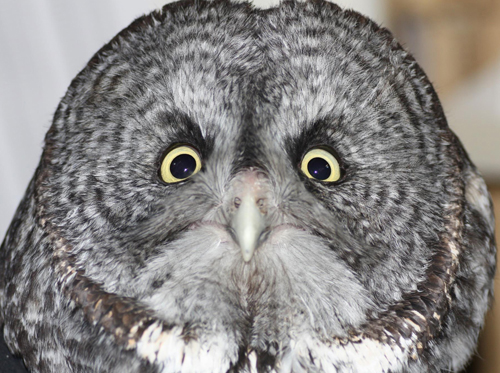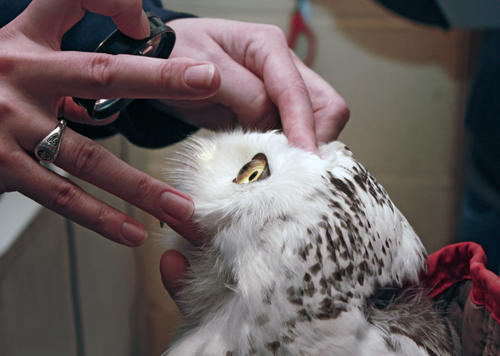
Research at the Ontario Veterinary College (OVC) is expanding baseline medical knowledge of iconic birds of prey found in North America’s boreal forests and arctic regions.
Earlier this year, a team of OVC researchers teamed up with the Owl Foundation rehabilitation centre in Vineland, Ont., to study the eyes of great grey owls as well as snowy owls. The group included Profs. Chantale Pinard, Stephanie Nykamp and Hugues Beaufrère, and intern Sarah Wills.
The researchers examined the eyes of 23 captive great grey owls and 19 snowy owls. Each bird was given a non-invasive ophthalmologic examination that included reflexes, slit lamp biomicroscopy, tear production, intraocular pressure, corneal measurements and ultrasound assessment.
The study is the first to document ocular findings in great grey owls. The group’s initial findings are reported in a research poster that won the best poster at the European College of Veterinary Ophthalmologists Congress held May 15 to 18 in London.
“This was a tremendous opportunity, and the people at the Owl Foundation were very accommodating and great to work with,” said Pinard, a board-certified veterinary ophthalmologist in the University of Guelph’s Department of Clinical Studies. “It was extremely interesting for me because we were dealing with an iconic avian species with very large interesting eyes, and generating new findings that have never been reported in the literature.”
Great greys are the largest owl in North America; however, their large head, long tail and fluffy feathers mask a body that is lighter than most other large owls. They are found in forested habitats from Alaska to parts of the Lower 48 states, Ontario and Quebec.
Each year, many great grey owls are brought to wildlife rescue and rehabilitation centres where they are treated for a variety of health issues, including eye-related problems. Because their eyes are so large – taking up most of the space in their skulls – they are highly susceptible to trauma and manifesting symptoms of systemic infectious diseases.
The study, which was expanded into an intern research project for Wills, was initiated by Beaufrère, chief of the OVC Health Sciences Centre Avian and Exotic Medicine Service, through his interest in birds of prey and contacts with the Owl Foundation. He says the findings are important because northern owls are not well studied compared to the more widespread temperate-zone species such as screech owls and barn owls.
“The goal of the study was to collect baseline data of what is normal in these owls,” he said. “Establishing reference values for ocular findings will help wildlife and zoo veterinarians interpret test results and diagnose and treat eye diseases and trauma in the birds that they see.”

Beaufrère also aims to answer the “what is normal?” question with respect to owls’ blood chemistry. In collaboration with Melanie Ammersbach, a PhD candidate in the Department of Pathobiology, Beaufrère recently completed the largest study to date of normal hematologic parameters in birds of prey. The research team analyzed the biochemical components of blood samples taken from 276 owls – from 13 species, including five types of boreal owls – in Canada and France. Results of the study, sponsored by Abaxis Canada, will be published soon in the journal Veterinary Clinical Pathology.
“Quite a lot is known about other birds of prey such as falcons and eagles, but owls have a completely different lifestyle and some unique physiological features,” said Beaufrère.
“In many areas across their range, owls are under pressure and face health challenges, including injuries related to human activities, hunger and competition for space, predation, parasites and infectious diseases such as West Nile virus. By establishing baseline parameters for healthy owls, we can help zoological institutions and organizations like the Owl Foundation with their breeding, rehabilitation and reintroduction programs that are essential to the long-term survival of these magnificent birds.”